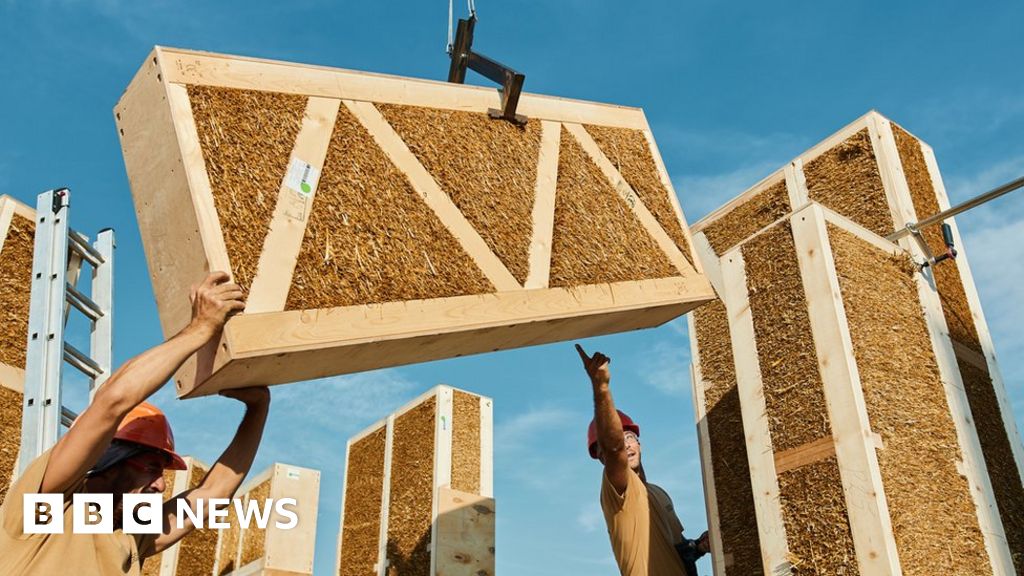This didn’t seem quite serious enough for UK, but it’s kinda neat.
Big Bad Wolf could not be reached for comment.
And as Insulation seems to have become my Special Interest at the moment, I dug into the material a little more.
It’s supposed to be installed 400mm thick.
It has a transmission value of 0.12WMK.
So 400mm on the outside of the house is equivalent to…150mm of glassfibre or 75mm of cellotex.
As it’s vapor permeable, it shouldn’t have any of the damp issues poorly installed insulation suffers from.
So, if you can get away with the look, and have the space outside, it’s a pretty cool (/warm) material.
I’m sure the fire department would love it
deleted by creator
If you’ve ever tried to burn a book, you can imagine that tightly packed straw would be hard to ignite. I wonder if they can spontaneously combust if water gets in and it starts to rot? Mainly a worry for green hay, but I wonder. https://www.ag.ndsu.edu/news/newsreleases/2011/july-25-2011/don2019t-risk-hay-fires/view
If you’ve ever tried to burn a book
Done much book burning recently?
It’s apparently 120 minute fire rated. On the outside of a building, that’s a fair amount (and certainly better than PIR board, see Grenfell!)
We rate materials and construction by how long it takes to burn, and that time is generally a reasonable amount of time to get out of the building. For example, a domestic ceiling needs to withstand for 30 minutes.My own experiments with Stieco found it was very hard to actually set alight on a bonfire. I’m not sure how straw fares, but the woodfibre based board tended to char and prevent further spread. (Until it reaches a flashpoint, I guess)
Fire rated, sure. But how does it hold up in a windstorm? Asking for a little pig friend.
Big bad wolf rubbing his hands too. Rookie mistakes people!
Something something … big bad wolf
Were these architects never children!? This is like telling your children, “If you get lost in the woods, look for a candy trail and an old stone cabin.”
Hmm interesting. Is the straw compressed?
I wonder if you could encapsulate straw with fiber reinforced plastic. That would make it properly watertight for a tiny house. You could even vacuum seal it or replace the air with an insulating gas / CO2. And theoretically the straw could then work as something a bit like a core material. Something like 1mm fiberglass is only like 5€/m² so a combination of those two could make for one of the cheapest building material. Ideally you’d use basalt instead of fiberglass and a more eco friendly resin, but the encapsulated energy for a tiny house is so little it doesn’t matter than much.
The move nowadays is towards natural materials that breathe (exchange water vapor), but do not pass liquid water between layers.
It’s a delicate balance to hit, and as soon as mineral fibres get involved, the breathability becomes trickier.I’d really prefer something fully sealed for that reason. No “delicate balance” or the need for clever wall design. Just water and air proof. But straw is probably the wrong material for this. I was imagining something simple like a quonset hut. Easy to make forms for it.
The trouble with fully sealed, is when it suddenly isn’t, but it’s not noticed. Because then you end up with moisture building up with nowhere to go.
There are definitely two paths, perfect seal, and managed permeability, and they both have their benefits.
The problem with encapsulation is that it’s never perfect. Look how many boats have rotten decks (all of them, eventually) and realize a house is way harder to do compared to a relatively simple boat. I live in a town where the climate will make mold grow on the north side of anything you set down for 5 minutes. I’d rather have no insulation at all than a biohazard in a box.
Hmm good point about encapsulation. But how is a house harder to encapsulate than a boat? I mean assuming the roof properly protects against rain, you have much less splash, the air humidity is generally lower and it’s not corrosive saltwater.
A boat you can take out of water and dry dock, seeing, analyzing, and fixing every interior and exterior surface. A house you cannot dry dock and check the exterior of the foundation under the soil.
Also, boats are made in a mould in a factory. Much smaller, many less nooks and crannies.
This is the best summary I could come up with:
Barbara Jones and her colleagues at Todmorden Learning Centre and Community Hub have hatched a plan to clad the college, built in the 1950s, in more than 1,600 sq metres of straw-stuffed panels - to better insulate it.
In panel systems, relatively short pieces of straw are packed together at just the right density, about 110 kg per metre cubed, so that the volume of air inside creates an insulating effect.
When it comes to new builds, however, rival firm Agile Property and Homes, which offers straw-stuffed panels previously marketed under the brand name ModCell, argues that incoming construction standards are likely to demand higher insulation levels in walls.
Consumers may be hesitant about buying a home built with lots of straw in the walls, suggests Richard Fitton, an expert in building physics at the University of Salford.
His own research suggests that straw does not present a significant fire risk and he points out that newer, panel-style systems featuring the material could be attractive to developers looking to reduce their environmental impact.
Because a large number of panels can be moved on a single truck from EcoCocon’s facilities in Central Europe, Ms Jones says the carbon savings achievable are still good.
The original article contains 946 words, the summary contains 202 words. Saved 79%. I’m a bot and I’m open source!






